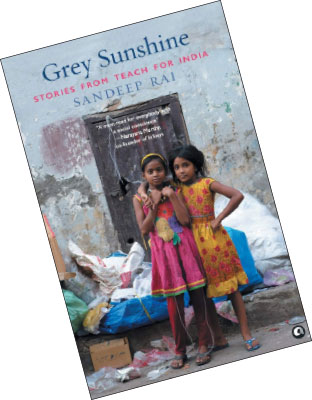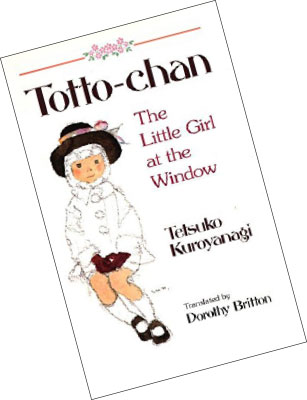

Readers of Rotary News are familiar with the ground realities of the education system in India. They don’t need proof of its denial to thousands of less privileged; at the same time, Rotary is itself engaged in innumerable projects that make quality education accessible to children. Children like the two bright little girls featured on the cover of Grey Sunshine by Sandeep Rai, Chief of City Operations with the Teach For India (TFI) programme.
This two-year fellowship programme places young people as full-time teachers in government classrooms across India in an effort to reform the system. So far, some 4,000 such teachers have engaged with children in government schools, impacting their lives and their futures in many positive ways. Their work has been effective enough even to power the odd child to further studies in prestigious schools/universities in the West.
Sandeep Rai, a child of Indian immigrants who opened a grocery store in the American Deep South, was on course to do medicine when he heard a sermon by preacher Keith Tonkel at the Wells Methodist Church in Jackson, Mississippi. “It is far too easy to look at those suffering and cast an eye of judgement — to ascribe their condition to lack of hard work or a fate that’s not in their control,” Tonkel said. “But it’s much harder to accept, to remember that we are no more deserving than them. … all of us, you and me, are in desperate need of grace that is unequivocally unmerited.”
This reminder of our “desperate need of grace” motivated Rai to remain in touch with Keith and, over the next three years, think long and deep about acceptance, service, poverty, love. Then, his mind made up, he told his parents that he was no longer keen on medicine, he would join a programme called Teach For America — and that’s what he did. This life-changing decision eventually led to his moving to India and becoming part of the Teach For India family.
Grey Sunshine records Rai’s memorable journey as well as the journeys of some teachers and students. Through sober and insightful reflection, Rai shares real stories. For instance, Nishi, the daughter of a tile labourer who migrated from Bihar, dreams of becoming a doctor. When she tells him how “Everyone looks down on low- income people. They think we’re lazy. But that’s not true. The world doesn’t even see us as people. They stay away from us. And that perception, whether we like it or not, limits our potential,” he recognises it as a fundamental truth in India.
Readers would have heard variations on this theme everywhere as I did, from a young woman working with children in Bhopal who pointed out that “our education system is so geared towards testing failure, I’d rather pull my children out of school.” It’s in this context that Rai’s observation that “dozens of studies have shown that expectations play a crucial role in the development of children” and that “those who are held to higher standards, regardless of background or ability, almost always perform better than their counterparts” makes perfect sense.
At the other end of the spectrum you have young people like Tarun from a middle/upper middle class background, forced to enroll in coaching centres to prepare for the IIT entrance exam. Rai recalls how Tarun, exhausted and exploited by the inhumane rigour of the system and racked by self-doubt, ran away from IIT coaching in Kota, wandered around the country, experienced real life and poverty in all its horror and humanity, and eventually went on to study in BITS Pilani before landing a job in Hindustan Lever. There he had an ‘ah’ moment and quit to become a TFI fellow so he could help children dream of becoming the best.
These young people and their wards touch the reader’s heart with their dreams and realities. They are thrown up by the vicissitudes of social and economic changes even as, sometimes, they become pawns in the hands of political forces that seek to divide people on the basis of religious belief and social stigma. The book takes us through the real battles that children and communities fight every day simply to remain afloat; the authenticity of the stories have the power to pummel the life out of every bigoted, divisive view or action by individuals posing as ‘nationalists’ and ‘reformers’ today. If they are open to reading or knowing, of course.
In Anurag’s class at the Babul Uloom, a makeshift school in Seelampur, northwest Delhi, the question of quality of education comes up for discussion one day which prompts a student called Aman to ask “Actually bhaiya, what is the education level in our country?” This prompts Anurag to tell them (and us) about ASER, the Annual State of Education Report, which says that more than 50 per cent of children in Class 5 can’t read Class 2 level textbooks, and two-thirds can’t do basic subtraction and addition. When the children discover that ASER did not study the education level in Seelampur, they devise a method of collecting data and analysing it. Eventually this led to their designing, planning and coordinating one of Delhi’s first student-led conferences called I-STEP (inspiring students, teachers, educators and parents). This later snowballed into a campaign called Lakhon Mein Ek covering 100,000 villages across India. Who says young teachers and their wards cannot ask questions and find solutions?

Poor quality teaching, mismanaged schools, struggling students — they exist all over the world and many books have been written about them, some even finding success as movies. Up the Down Staircase by Bel Kaufman (1964) was 64 weeks on The NYT’s bestseller list; To Sir With Love (1959), an autobiographical novel set in London’s East End by E R Braithwaite was made into a hit film. Its title song sung by Lulu even topped the charts when I was a schoolgirl. Then there’s Totto-chan: The Little Girl at the Window (1981), an autobiographical memoir by Japanese TV personality Tetsuko Kuroyanagi about the unconventional education she received at Tomoe Takuen, an elementary school in Tokyo, during the Second World War. Incidentally, in an eerie connection to the observation made by the young woman from Bhopal, Wikipedia says the Japanese name of the book is an expression used to describe people who have failed.
Pulitzer Prize-winning author Frank McCourt was a teacher practically all his adult life. He has recorded his experiences teaching in New York schools and colleges in the memoir, Teacher Man (2005). Gritty yet compassionate, the book felicitously recounts the trials and frustrations and occasional successes of teaching young people growing up in strained circumstances, constantly under the threat of drugs, drinking, shooting and rank poverty.
The 1999 nonfiction work The Freedom Writers Diary: How a Teacher and 150 Teens Used Writing to Change Themselves and the World Around Them was written by a group of students and their teacher Erin Gruwell from Woodrow Wilson High School in California. It is based on journals the students were encouraged to keep in which they recorded the troubles of their past, present and future.
TFI is all about the possibility of change — material, mental, emotional, social, economic and political, thanks to its founder Shaheen Mistri. After travelling with her parents to various corners of the world, this young woman settled in Mumbai. Her worldview radically changed when she saw children spending days and evenings loitering at traffic signals. After first founding the Akanksha Foundation committed to serving needy urban children, she founded Teach For India on the Teach For America fellowship model. The final words, therefore, belong to her. In Rai’s book, she writes about an imagined Museum of Grey Sunshine dedicated to educational inequity. “I yearn to visit the Museum of Grey Sunshine one day,” she writes, “to be reminded that we’ve turned the Classrooms of Oppression into Classrooms of Light. I yearn for the day the grey disappears.”
The columnist is a children’s writer and senior journalist.





